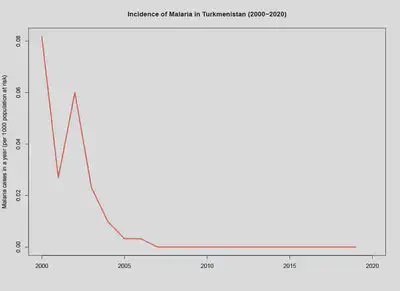2010

Overview
Turkmenistan was WHO certified malaria-free in 2010 with the last indigenous case being reported in 2006. Initial malaria elimination efforts began in Turkmenistan following the Second World War, which included malaria surveillance as well as control strategies like malaria control stations and quinine distribution posts. This led to the elimination of malaria in Turkmenistan in 1961. From 1961 to 1990, the country worked to prevent the reintroduction of malaria by implementing a vigilance system based on the recommendations from the WHO Global Malaria Eradication Program. This system involved malaria surveillance, malaria screening of high-risk groups, and health education. However, Turkmenistan experienced a resurgence of malaria with outbreaks in 1998–99 and 2002–2003 contributed by military training activities and migrant worker mobility and partly due to a weakening of the surveillance system. Post-outbreak, malaria surveillance was strengthened and the Sanitary Epidemiological Service and healthcare facilities were mobilized. The Sanitary Epidemiological Service is a response team consisting of clinicians, epidemiologists, parasitologists, entomologists, and laboratory technicians that work to eliminate sources of infection through case detection and investigation, vector control through indoor residual spraying and larviciding, and health education. The malaria programme also ensured the supply of malaria control stocks well after the outbreak was contained. Turkmenistan worked to eliminate malaria through a national plan of action that was centered on active case detection and management and was able to achieve malaria elimination in 2010.
Malaria Incidence in Turkmenistan (2000-2020)
| Year | Incidence of malaria (per 1,000 population at risk) |
|---|---|
| 2000 | 0.081758 |
| 2001 | 0.026966 |
| 2002 | 0.060070 |
| 2003 | 0.023131 |
| 2004 | 0.009813 |
| 2005 | 0.003236 |
| 2006 | 0.003198 |
| 2007 | 0 |
| 2008 | 0 |
| 2009 | 0 |
| 2010 | 0 |
| 2011 | 0 |
| 2012 | 0 |
| 2013 | 0 |
| 2014 | 0 |
| 2015 | 0 |
| 2016 | 0 |
| 2017 | 0 |
| 2018 | 0 |
| 2019 | 0 |
| 2020 | Data unavailable |
References
Amangel’diev, K. A. (2001). Current malaria situation in Turkmenistan. Meditsinskaia Parazitologiia i Parazitarnye Bolezni, (1), 37-39.
Shamuradova, L., Alieva, S., Kurdova-Mintcheva, R., Rietveld, A., Cibulskis, R., Ejov, M., … & Newman, R. D. (2012). Achieving malaria elimination and certification in Turkmenistan. Malaria Journal, 11(1), 1-2.
Smith Gueye, C., Newby, G., Tulloch, J., Slutsker, L., Tanner, M., & Gosling, R. D. (2016). The central role of national programme management for the achievement of malaria elimination: a cross case-study analysis of nine malaria programmes. Malaria journal, 15(1), 1-21.
World Health Organization. Global Malaria Programme & University of California, San Francisco. (2012). Achieving elimination in Turkmenistan. World Health Organization. https://apps.who.int/iris/handle/10665/75848